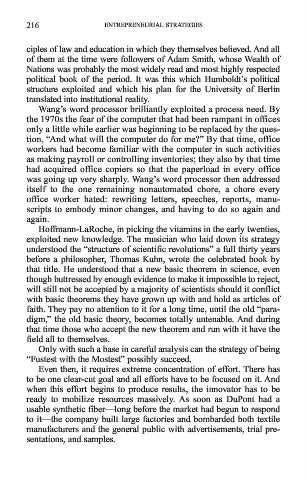Page 223 - ENTREPRENEURSHIP Innovation and entrepreneurship
P. 223
53231_Innovation and Entrepreneurship.qxd 11/8/2002 10:50 AM Page 216
216 ENTREPRENEURIAL STRATEGIES
ciples of law and education in which they themselves believed. And all
of them at the time were followers of Adam Smith, whose Wealth of
Nations was probably the most widely read and most highly respected
political book of the period. It was this which Humboldt’s political
structure exploited and which his plan for the University of Berlin
translated into institutional reality.
Wang’s word processor brilliantly exploited a process need. By
the 1970s the fear of the computer that had been rampant in offices
only a little while earlier was beginning to be replaced by the ques-
tion, “And what will the computer do for me?” By that time, office
workers had become familiar with the computer in such activities
as making payroll or controlling inventories; they also by that time
had acquired office copiers so that the paperload in every office
was going up very sharply. Wang’s word processor then addressed
itself to the one remaining nonautomated chore, a chore every
office worker hated: rewriting letters, speeches, reports, manu-
scripts to embody minor changes, and having to do so again and
again.
Hoffmann-LaRoche, in picking the vitamins in the early twenties,
exploited new knowledge. The musician who laid down its strategy
understood the “structure of scientific revolutions” a full thirty years
before a philosopher, Thomas Kuhn, wrote the celebrated book by
that title. He understood that a new basic theorem in science, even
though buttressed by enough evidence to make it impossible to reject,
will still not be accepted by a majority of scientists should it conflict
with basic theorems they have grown up with and hold as articles of
faith. They pay no attention to it for a long time, until the old “para-
digm,” the old basic theory, becomes totally untenable. And during
that time those who accept the new theorem and run with it have the
field all to themselves.
Only with such a base in careful analysis can the strategy of being
“Fustest with the Mostest” possibly succeed.
Even then, it requires extreme concentration of effort. There has
to be one clear-cut goal and all efforts have to be focused on it. And
when this effort begins to produce results, the innovator has to be
ready to mobilize resources massively. As soon as DuPont had a
usable synthetic fiber—long before the market had begun to respond
to it—the company built large factories and bombarded both textile
manufacturers and the general public with advertisements, trial pre-
sentations, and samples.

